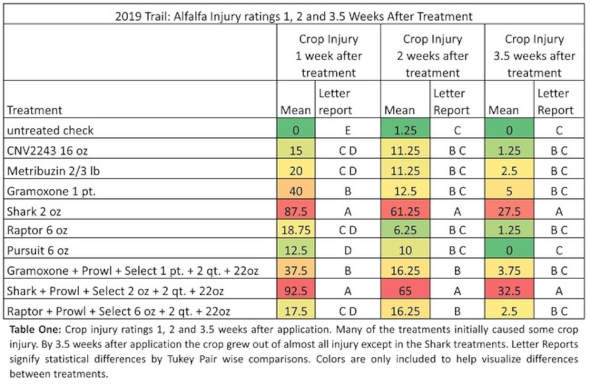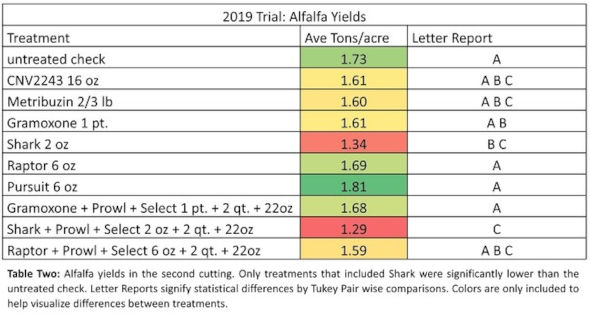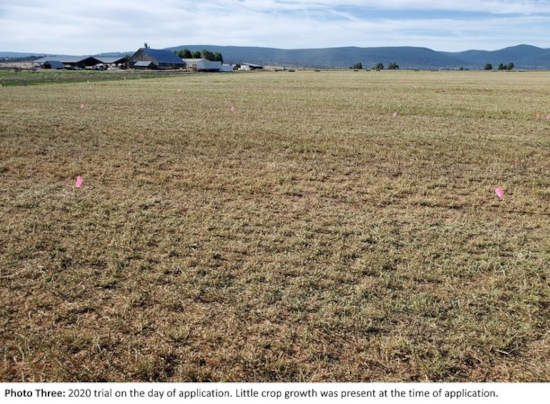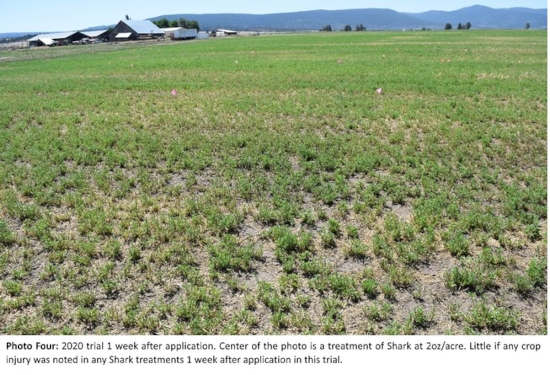By Thomas Getts
Over the past two seasons I have been involved with testing an experimental herbicide for weed control in alfalfa. There was an initial trial implemented at the Intermountain REC in Tulelake California during the 2019 growing season. The main goal of the trial was to test crop safety of an experimental herbicide on alfalfa where applications were made between cuttings. As I was already putting a trial out, it seemed worthwhile to test various other treatments for comparative crop safety. (Some of the treatments tested are registered for use between cuttings, others are not. Both registered and unregistered products were tested. Always read and follow the label whenever using a pesticide).
However, this blog post is not going to focus on the experimental product, but instead a treatment that caused more crop injury than I expected. One of the herbicides tested was the PPO inhibitor Shark (carfentrazone), which is a good burn down herbicide for small annual weeds in alfalfa. I had tested Shark as a dormant season treatment in the past and seen some crop injury, but the alfalfa had always grown out of it by the time first cutting came around. Shark is also labeled for weed control in alfalfa for applications “between cuttings” and can be used to target recently germinated summer annual weed species. The label indicates that Shark applications can be made to alfalfa stubble after cutting, up to 6 inches of crop regrowth if there are at least 21 days prior to harvest
In the 2019 trial, applications were made prior to any irrigation following cutting. The crop was 4-5 inches tall at the time of application and was already regrowing even though no irrigation water had been applied (Photo one). The soil at the research station is a silty clay with high organic matter and good water holding capacity. The two treatments that contained Shark showed significant crop injury to the alfalfa 1 and 2 weeks after application. (Table one and Photo Two). Unlike the injury I had seen in dormant treatments of Shark, crop injury was still present in this trial when it came time to cut. The only two treatments to cause a significant yield reduction in the trial contained Shark in the mix, with a 4 tenths of a ton/acre yield reduction (Table 2). This was surprising to me because the Shark application was made according to label instructions. While I anticipated seeing some injury, I was not anticipating a yield loss prior to implementing the trial. On another note, there was no yield reduction from the experimental herbicide treatment, which was good news as we have continued to investigate crop safety of that product in 2020. Other herbicides tested initially cause some crop injury (table one), but none of them significantly impacted yield during the second cutting.



This year I wanted to look at Shark in another trial at a different field location. Was injury always to be expected? (I doubt it). This data is hot off the press, as I took the first “injury” ratings from the 2020 plots Friday. Crop injury data can be seen in table three and a picture of one of the Shark treatments can be seen in photo four. If you look hard, there is a little leaf burn on the alfalfa here and there in the Shark plots, but generally the crop looked very similar to the untreated check. This was a night and day difference between what was observed in 2019.
What was the difference between the two sites in 2019 and 2020?
In 2019 the crop was actively pushing out some new growth at time of application. While no irrigation had been applied, the Tulelake research station sits on a good deep silty clay loam soil, with high organic matter. As photo two shows the crop regrowth was burned back to the ground in the 2019 trial and one week after application was not growing at all. The second site in 2020 was in a much different situation. The field was behind on water at no fault of the grower cooperator, as thunderstorms, “materialized” suddenly on the forecast two weeks in a row delaying the first cutting. The trial was located on a shallower sandy loam soil and very little crop growth had occurred prior to the herbicide application, with a few leaves here and there (photo three). There was not much active growth crop at the time of application. The lack of injury 1 week after application at the 2020 field site initially shows very good crop safety in this situation, much different than the 2019 location. Considering Shark is a burndown herbicide with little residual actively, I would suspect second cutting yield at the 2020 field site will not be influenced. (However, we will just have to wait and see!)


Year to year, site to site, these two trials show that depending on the conditions, the potential for crop injury can be dramatically different with in-season applications. If this were on a field scale, one of the growers would have been happy with the decision to treat, where the other would have been devastated.
If you have germinating summer annual weeds in your alfalfa, Shark can be a good option to knock them back with an in-between cutting application. However, making in-season applications of conventional herbicides has some potential for crop injury and the risk of crop injury must be weighted with the need to control the weeds. When it comes to these two case studies with Shark, the more crop growth at time of application, the more potential to set the crop back. Where fields without much growth may be better candidates for applications of a burndown product like Shark. Hopefully, your alfalfa fields are looking clean and you do not need to make any in-season herbicide applications!